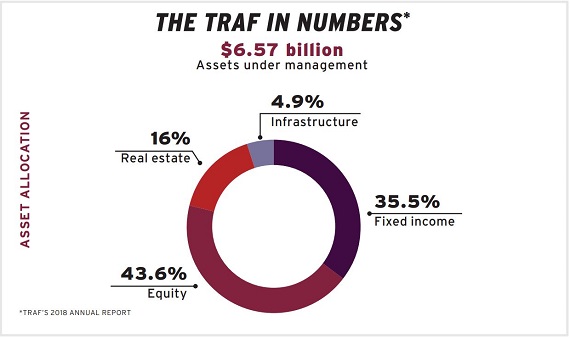
Since the Teachers’ Retirement Allowance Fund, which is the defined benefit pension plan for public school teachers and other eligible employees in Manitoba, was introduced in 1925, it has made significant strides around asset mix and governance.
In the early days, the fund’s asset mix consisted largely of federal, provincial and municipal bonds, but in 1976, it made its first foray into private markets with real estate, says Graeme Hay, the TRAF’s vice-president of investments. This continued with the plan allocating to private equity in the 1980s and infrastructure in 2006.
“At first, it was small opportunistic allocations in our equity portfolio and then in the early 2000s we started taking on more meaningful weight in private equity. And today we have a six per cent allocation, which is a broadly diversified program of fund of funds, primary fund commitments and co-investments.”
Read: Newfoundland and Labrador Teachers’ Pension Plan bouncing back under JSPP model
In addition to these asset mix adjustments, the plan made more recent changes to its governance, notes Hay. Initially, investment recommendations went to its investment committee and board, but in 2013, a new policy was approved to delegate more to the chief executive officer.
“Certainly, [in] managing a well-diversified private market portfolio there’s always re-ups into funds, there was co-investment opportunities, it could be very, very busy to manage, and it didn’t necessarily make sense to bring what could be a small re-up investment back to our investment committee,” says Hay.
As such, the board granted greater authority to the management team, which has generally worked well, he adds. Yet, as the investment department grew and the team became more specialized, the plan decided to build another layer of oversight and governance within the organization — an internal investment committee.
Beginning in 2016, any investment recommendation — whether directed at the statutory investment committee or delegated — goes to an internal investment committee comprised of the entire investment team, the head of the legal department and the chief risk officer. “It was basically trying to mirror the good governance that we already had in place with our investment committee and board, and just mirroring that when it came to investment decisions we undertake internally,” says Hay.
Read: The Wawanesa Mutual Insurance Co. pension plan’s OCIO journey
Getting to know
Graeme Hay
Job title: Vice-president, investments
Joined the TRAF: 2013
What keeps him up at night: Trying to add investment value in a consistent way, so that periods of underperformance are small and don’t persist for a long time
Outside of the office he can be found: With his two young boys and wife at the hockey arena or a football game
The internal investment committee is scheduled to meet once a month, but can also be called on an as-needed basis. This structure has helped ensure a diversity of perspectives, not only when it comes to investment matters, but also to include voices to comment on other risks like operational, tax and legal matters, he notes.
It also offers benefits from a cultural perspective. “The team has always had a common objective of meeting the investment objectives for the plan. But getting all together, talking about investment recommendations, helps to foster consensus across the team that when we’re pursuing a certain investment opportunity, we all share in the risks and rewards of that opportunity and we can all weigh the benefits of something we’re considering versus what we already have in the portfolio.”
And the internal investment committee has sharpened the due diligence process, he adds.
Read: Governance at core of success in CAAT plan’s shift to private markets
Co-investments is one example of how the new committee has helped the plan thrive. “Having the broad investment team and some of our other leaders and professionals within the organization that are more focused on tax and operational and legal issues, allows us to be a little more nimble to some degree.”

From a governance perspective, despite the potential time-sensitive nature of co-investments, the plan doesn’t want to compromise its due diligence process, notes Hay. “Having the structure in place means that we follow the same process, whether it’s something we’ve been working on for months or something we’ve been working on for weeks.”
Although the TRAF has made a lot of progress in re-shaping its governance, work is still underway to refine its delegation policy, which to date has been focused on private market investments and particularly re-ups and co-investments. Specifically, the policy limits the amount of annual investment commitment on a delegated basis and also has set limits for each asset class.
“That’s worked pretty well for us,” adds Hay. “The thing we’ve been evaluating lately is just how those limits and how those controls might be adjusted based on where we’re at today, with an even more diversified portfolio of manager relationships and what makes the most sense given the limited time that we have with the investment committee and board.”
Yaelle Gang is editor of the Canadian Investment Review.
